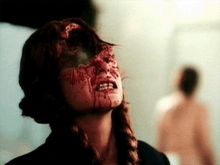
Wes Craven's Scream is a smug, stupid film that is inordinately pleased with itself. Craven thinks he's clever, but the film is postmodernism for dummies, a braying donkey of a movie that can't stop honking instructions at the audience about how to watch. Possibly more irritating than the film itself was the mainstream critical response. Critics praised Craven for breaking new ground in the horror genre and ushering in a shiny new era of self-reflexivity and self-awareness. Meta-horror! Whoo! The problem with this praise (besides overrating a film with bad acting, editing, writing, and shot composition) is that the horror genre had already pioneered this critical self-awareness for decades before Craven cashed in, with more wit, style, respect for the audience, and respect for the genre. Craven had even, clumsily, done it himself two years before Scream with his postmodern Nightmare on Elm Street sequel, New Nightmare. It wasn't a very good movie, but it was much more ambitious than Scream.

Critics in the Family Guy reference-bludgeon era who pretended Scream was something new should have been pantsed (or de-pantsed, depending on your regional slang) and forced to watch Spanish director Bigas Luna's Anguish, a movie about watching movies, generally, and horror movies, specifically. A postmodern delight, this film within a film within a film within a circle within a spiral within a wheel within a wheel is a blackly comic horror gem that is clever, but not too clever. This is a movie made by a movie lover, intended for movie lovers. It replaces Craven's contempt and self-satisfaction with authentic pleasure and fun.

WARNING: Anguish is almost impossible to write about without giving away spoilers, so proceed at your own risk. I'm not a plot-oriented moviegoer, so I don't mind spoilers myself, but a fresh viewing of this movie with no idea what to expect would be something sweet.

Anguish opens with a funny William Castle-esque warning about hypnosis and then enters the home of Zelda Rubinstein (Poltergeist) and her son Michael Lerner (Barton Fink, A Serious Man). He's an orderly for a prominent eye surgeon, and he and his mother are both pretty nuts. Zelda has some powers of clairvoyance, and she flips out when her son is accosted by a rude patient. She hypnotizes him and instructs him to kill the woman and steal her eyeballs. When things get even worse for Lerner at his job, Zelda sends her son on a hypnotic killing and eyeball-stealing spree. This portion of the film, formally and structurally, resembles a combination of Castle-style '50s horror gimmickry and the '70s Italian horror of Argento and Fulci. It's a clever and interesting mix, but the movie is just getting warmed up.

After the first two killings, the camera pans back and reveals this portion of the film as a film. We're in a dark theater, watching it on a big screen with an audience. The rest of Anguish cuts back and forth between the people in the theater watching the horror movie, the horror movie they're watching, and both at the same time as events in the theater begin to parallel what's on the screen. When Lerner's character in the film-within-a-film goes into a movie theater himself to start his killing spree, I really wished I was watching Anguish on a big screen instead of a DVD. Audiences in a theater get the experience of watching people on a big screen watch people on a big screen watch people on a big screen. I love that.
When the film reveals itself as a film-within-a-film, the audience members become characters and Anguish becomes a film about how we watch movies. Some people are bored, some entranced, some disturbed, some hypnotized. We focus mostly on two teenage girls who are experiencing vastly different things. One girl loves the film while the other feels frightened and ill. She wants to leave and whines a lot while the other girl tries to shut her up. Another audience member near them gives her the creeps. He seems a little unhinged. Later, we'll find out he's very unhinged. He really loves the movie. I'll just leave it at that.

This English-language film by Spanish director Bigas Luna is one of his rare forays into horror. Called the Russ Meyer of Spain by a few critics, Luna gained his arthouse reputation by making visually audacious sex comedies and giving Javier Bardem his first major roles. I haven't seen any of his other films, but Anguish really makes me want to give them a look. This movie could have easily been a cloying, overbearing mess in the wrong hands, but Luna gets everything right. In most films-within-films, one of the two pieces is throwaway junk. Here, the horror film the audience watches is just as interesting and beautifully shot as the rest of the movie. Unlike Craven's running commentary throughout Scream, Luna relaxes and tells his story with images, not words. This is an enormously entertaining film about the ways we watch movies. It's funny and suspenseful and horror fans and movie lovers in general should check it out.









